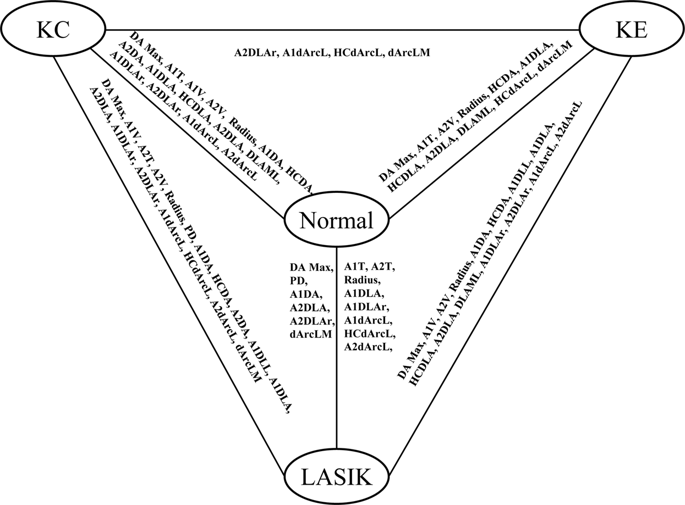Scientific Reports ( IF 3.8 ) Pub Date : 2020-03-30 , DOI: 10.1038/s41598-020-62825-y Kaili Yang 1 , Liyan Xu 1 , Qi Fan 1 , Yuwei Gu 1 , Peng Song 1 , Bo Zhang 1 , Dongqing Zhao 1 , Chenjiu Pang 1 , Shengwei Ren 1

|
The aim of this study was to evaluate the distribution of new Corneal Visualisation Scheimpflug Technology (Corvis ST) parameters in normal, Post-laser in situ keratomileusis (LASIK), Post-LASIK keratectasia (KE) and keratoconus (KC) eyes, and explore the diagnostic ability of these parameters in distinguishing KE from LASIK eyes. Twenty-three normal eyes, 23 LASIK eyes, 23 KE eyes and 23 KC eyes were recruited in this study. The following new Corvis ST parameters were measured: Max Inverse Radius, deformation amplitude (DA) Ratio Max [2 mm], Pachy Slope, DA Ratio Max [1 mm], Ambrosio’s relational thickness horizontal (ARTh), Integrated Radius, stiffness parameter at first applanation (SP-A1) and Corvis biomechanical index (CBI). The general linear model, linear regression model, relation analysis and receiver operating characteristic (ROC) curve were performed. The Max Inverse Radius, DA Ratio Max [2 mm], Pachy Slope, DA Ratio Max [1 mm], Integrated Radius and CBI in LASIK eyes, KE eyes and KC eyes were higher than in normal eyes, while the ARTh and SP-A1 parameters were lower than in normal eyes. The KE eyes had higher Max Inverse Radius, DA Ratio Max [2 mm], Pachy Slope, DA Ratio Max [1 mm], Integrated Radius, and lower SP-A1 value than LASIK eyes (all P < 0.05). The central corneal thickness was related to the Pachy Slope (r = −0.485), ARTh (r = −0.766), SP-A1 (r = 0.618) in KE eyes (all P < 0.05). The area under the ROC curve of Integrated Radius, Max Inverse Radius, DA Ratio Max [2 mm] and SP-A1 were above 0.800 in identifying KE from LASIK eyes. Thus, the new Corvis ST parameters were different between LASIK and KE eyes, suggesting that they might be helpful in distinguishing KE eyes from LASIK eyes. However, a further multi-center and large sample study is necessary to confirm these findings.
中文翻译:

在正常,LASIK术后,LASIK术后角膜形成和圆锥角膜中评估新的Corvis ST参数。
这项研究的目的是评估正常的激光后原位角膜可视化Scheimpflug技术(Corvis ST)参数的分布角膜磨镶术(LASIK),LASIK术后角膜扩张(KE)和圆锥角膜(KC)眼,并探讨这些参数在区分KE和LASIK眼中的诊断能力。在这项研究中,共招募了23只正常眼,23副LASIK眼,23 KE眼和23 KC眼。测量了以下新的Corvis ST参数:最大反半径,最大变形幅度(DA)比[2 mm],大斜率,DA最大比[1 mm],Ambrosio水平相对厚度(ARTh),综合半径,刚度参数第一压平(SP-A1)和Corvis生物力学指数(CBI)。进行了一般线性模型,线性回归模型,关系分析和接收器工作特性(ROC)曲线。最大反半径,DA比最大[2 mm],上斜率,DA比最大[1 mm],LASIK眼睛的综合半径和CBI,KE眼和KC眼高于正常眼,而ARTh和SP-A1参数低于正常眼。与LASIK眼相比,KE眼的最大逆半径,DA比最大[2 mm],上斜率,DA比最大[1 mm],综合半径和更低的SP-A1值均较高。P <0.05)。KE眼中中央角膜厚度与Pachy斜率(r = -0.485),ARTh(r = -0.766),SP-A1(r = 0.618)有关(所有P <0.05)。从LASIK眼识别KE时,总半径,最大反半径,DA比最大值[2 mm]和SP-A1的ROC曲线下面积均大于0.800。因此,新的Corvis ST参数在LASIK和KE眼之间是不同的,这表明它们可能有助于区分KE眼和LASIK眼。但是,需要进一步的多中心和大样本研究来确认这些发现。






























 京公网安备 11010802027423号
京公网安备 11010802027423号